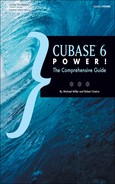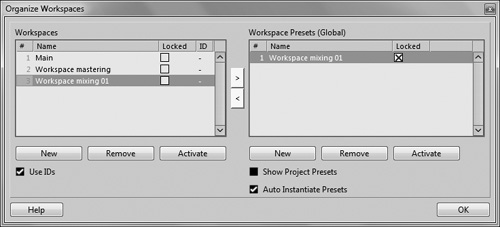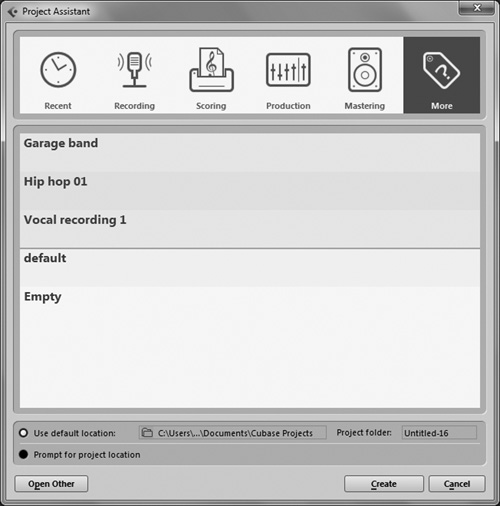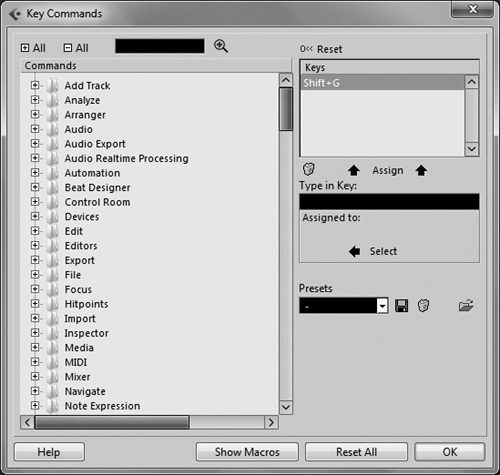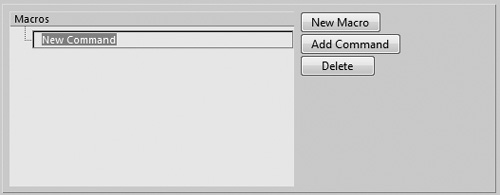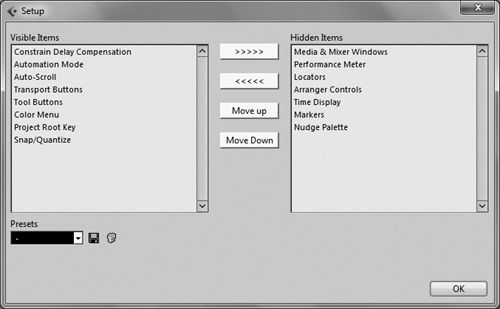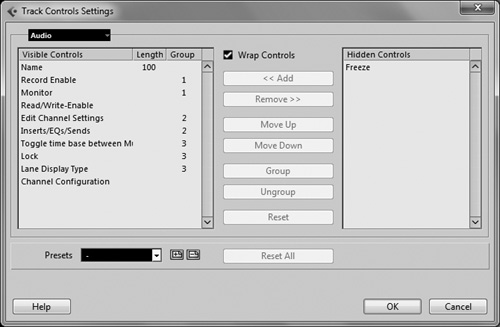Once you start getting comfortable with Cubase, working habits will also start settling into place. That’s when you’ll start wondering whether you can customize where tools are laid out and how you can more efficiently do the actions you perform the most often. This chapter discusses ways that you can customize settings and create reusable documents to suit your working preferences and habits.
Here’s a summary of what you will learn in this chapter:
How to create and organize your Workspaces
How to create a project template
How to customize key commands
How to create a macro and add commands to it
How to use a macro in a project
How to change the appearance of a toolbar and save this customization
How to show/hide Transport panel sections
How to create customized track controls for the Track List area and select customized settings
Given all the possible windows and controls necessary in even a moderately sized recording project, screen real estate and the layout of those windows are of primary importance. As such, Cubase’s Workspace feature helps you organize your on-screen Workspace.
Workspaces provide an easy way to recall a particular window layout for your Cubase project, such as a useful view for editing events, or a wide Mixer panel for the mix-down phase of a project. Workspaces are saved along with the project file or can be saved as presets that are available for all projects in Cubase. Workspaces and Workspace presets retain the current position and state of windows inside a project, but not the project-specific content within windows, such as a part loaded in a particular editor or the size of the main Cubase window on the desktop.
You can create several Workspaces and recall them through a set of customized key commands. You’ll find more on how to customize key commands later in this chapter.
When we work, we often start with basic settings. For example, if you have a favorite VSTi that you load for drums, a favorite window layout, a typical bus routing, or a number of tracks that you always name the same way, you might consider creating a template.
Templates are Cubase project documents that are saved in a Template folder. Saving a project as a template before you start recording events into it allows you to save all these settings, including preferences, output and input settings, and all the previously mentioned settings.
To use a template, select File (PC)/Cubase (Mac) > Create New Project. This opens the Project Assistant, shown in Figure 39.2. Click the More tab to view all the template files you’ve created.
Because templates are just like regular project files, you can use Windows Explorer or the Mac Finder to rename or delete them from your hard drive and subsequently change the template list. This also means that you can save audio and MIDI events within a template file if necessary.
Throughout this book, references are made to key commands, also known as keyboard shortcuts. Although Cubase provides a default set of key commands for a number of functions and operations, you can change these default settings to reflect your working habits better and add some of your personal favorites to the existing key commands.
The commands that can be associated with keyboard shortcuts are found in the Key Commands dialog box, which you open by selecting File (PC)/Cubase (Mac) > Key Commands. As you can see in Figure 39.3, all the key commands are grouped by category in the Commands list area; you can also use the Search box to search for specific commands. The keyboard shortcut associated with a given command is displayed in the Keys list on the right.
Within the Key Commands dialog box, the Recycle Bin (Delete) icon below the Keys area removes the keyboard shortcut associated with a selected command. The Presets field below manages the previously saved presets or enables you to save a preset to memory.
Note that there are already presets available for Cubase VST and selected other applications. Using the same shortcuts to do the same tasks from one software program to the next can make sense, so if you’re used to working with a specific set of keyboard shortcuts, this dialog box customizes the key command associations to better meet your needs.
Using Cubase macros is a way to save a sequence of tasks that you perform regularly, one after the other. For example, you might often need to quickly create four audio tracks and a marker track, select a window layout, and select a zoom level. Performing these tasks can take many steps—or only a single step when programmed as a macro command.
Now your new macro is created, but it won’t do anything. Let’s add commands to it.
Cubase enables you to easily change the tools that are displayed in a window’s toolbar and save these layouts for further use. This can come in handy when you need certain tools during one part of your creative process, but not during another. Also, depending on the resolution currently selected for your computer’s display, you may not have enough space on-screen to display all the tools at once—this may particularly be the case with the Project window toolbar, for example.
You can also save these customizations and select them later from the same context menu. This is a very useful technique that you should try to incorporate as soon as possible in your learning process with Cubase.
If you want to return the toolbar to its default state, you can do so by selecting the Default option in the same context menu, or you can choose to display all the available toolbar items by selecting the Show All option instead.
You can choose to hide certain portions of the Transport panel if you don’t need them or if you want to free up some valuable desktop space. Later, you can choose to redisplay any hidden areas of the Transport panel.
Although working with controls in the Track List is convenient, sometimes dealing with all the controls available might become cumbersome and confusing. Certain controls are used only during the recording process, whereas others are used only during the editing process. Furthermore, some users might never use a particular control from the Track List, using the Inspector or Mixer panel instead, whereas others might never use the Mixer panel and only use the Track List.
You can customize the controls that are displayed in the Track List, save these settings for each track class, and recall them later when you need them.
To select a customized track control setting, select the appropriate preset from the Track Controls drop-down menu found at the top-left corner of the Track List area.
